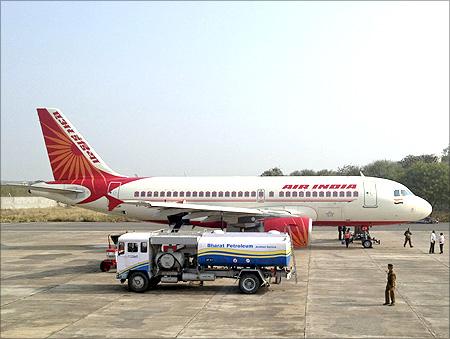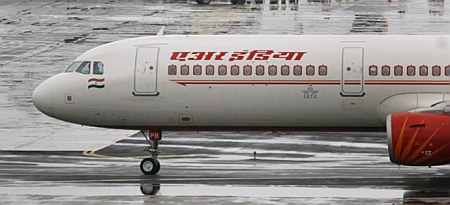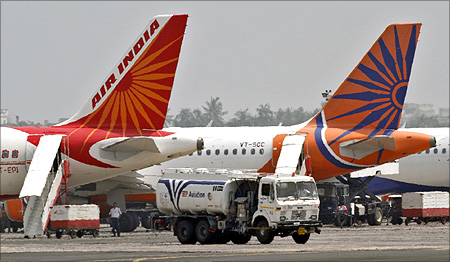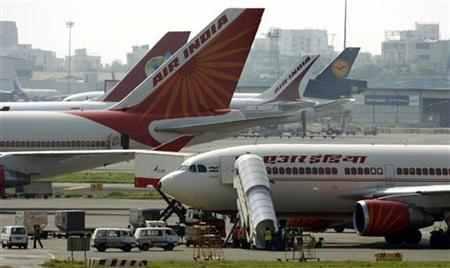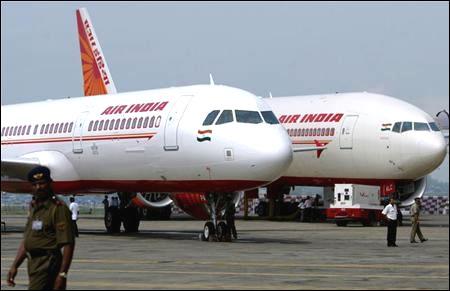 | « Back to article | Print this article |
Sinking story: Why Air India's nightmare continues
When 310 of Air India's 450 pilots went on strike, they had little idea many of them would be pleading for their jobs to be given back forty days later. Yet, this is the latest imbroglio that the national carrier finds itself in.
The Indian Pilots Guild (IPG), which represents Air India's pilots, was completely blindsided by an unbending, newly appointed civil aviation minister, Ajit Singh.
It had no idea that Singh would simply pick up the gauntlet thrown to him and turn the tables on the hapless pilots.
Click NEXT to read more...
Sinking story: Why Air India's nightmare continues
Singh not only terminated the services of 101 of the striking pilots, but also de-recognised the union. This means its representatives will not be called for negotiations by the management.
The minister insisted the agitation be called off first, only then would taking the pilots back be considered and, that too on a case-by-case basis.
In the meantime, the airline prepared a contingency plan to operate 75 per cent of its international flights.
Click NEXT to read more...
Sinking story: Why Air India's nightmare continues
Some industry experts view this Bismarckian stance in a positive light. "This is a welcome approach, since the authority of the Air India management has to be firmly established. Its dilution may lead to more agitations, as we have repeatedly seen in the past", says Amber Dubey, partner and head (aviation) at KPMG, a global consultancy firm.
However, the strike seems to go beyond just the pilots' obduracy.
More than anything else, it is a classic scenario of the complications that may arise due to a failure in troubleshooting a merger of two entities.
Click NEXT to read more...
Sinking story: Why Air India's nightmare continues
Here is what lies at the heart of the Air India problem: Even as it had merged with Indian Airlines in 2005, the pilots of the two airlines stuck to flying the aircraft attached to their respective airlines - wide-bodied ones used for international legs in the case of Air India, and the more short-haul, narrow-bodied ones in the case of Indian Airlines.
What threw the existing state of affairs into a loop was the entry of the much-hyped 'Dreamliners'-wide-bodied Boeing 787s that promised to help turn things around for Air India.
Click NEXT to read more...
Sinking story: Why Air India's nightmare continues
The match that lit the tinder hot was a proposal to get an equal number of Indian Airlines pilots and Air India ones to fly the twenty-seven planes that Air India would take delivery of in the next few years.
Yet, not all pilots are made equal, apparently. In Indian Airlines, it took six years to automatically become a commander.
In Air India, it took ten, but only if there was a vacancy available.
Click NEXT to read more...
Sinking story: Why Air India's nightmare continues
Someone in Air India who was waiting in the wings for, say, fifteen years to become commander would probably be enraged to see a six-years-in-service, narrow-body aircraft pilot, substantially junior to him, occupy his turf and deny him his long-awaited promotion.
With eight pairs of pilots required for each Dreamliner, as many as 432 pilots would have had to be trained once all the 27 planes were delivered.
Click NEXT to read more...
Sinking story: Why Air India's nightmare continues
This would have brought most of the erstwhile Air India pilots their long-awaited promotions. In fact, Air India had hired pilots to handle the increase in the international fleet size, from 23 to around 50 after the induction of the new planes.
Industry observers say that the whole problem lies in the very genesis of the union of the two entities.
Click NEXT to read more...
Sinking story: Why Air India's nightmare continues
"Airlines like Air France-KLM let the pilots function as separate units under one airline. The fact is that Air India's merger was badly planned and operating it as two separate units under one airline would have solved many of the problems," an industry insider, who does not want to be identified, says.
If the airline wanted to bring the pilots together under one entity, it could have asked them to choose from among several options that strived for parity.
Click NEXT to read more...
Sinking story: Why Air India's nightmare continues
"When British Airways was formed after the merger of four airlines, the pilots flying narrow-body planes and eligible to be promoted as commanders were given an option to either become commanders on narrow bodies, or to become co-pilots on wide-body planes and then get promoted as commanders," he says, adding that such a solution would have resolved all conflicts.
Apparently, IPG pilots say that this issue - of competing pilots and aircraft type - was to be resolved by the Justice Dharmadhikari committee.
But Air India pushed through a policy in October 2011 under which equal number of pilots of the formerly separate airlines would train for the Dreamliner. IPG objected, went to court, and lost.
Click NEXT to read more...
Sinking story: Why Air India's nightmare continues
For Air India, this impasse can turn out a sizeable blow, that too when the airline is witnessing a large increase in revenues and an improvement in operations.
A substantial part of the airline's sales - Rs 15 crore (Rs 15 million) of the daily revenues of Rs 22 crore (Rs 220 million) - comes from international operations. This has been hit.
Ultimately, the one taking the biggest blow is the taxpayer. Therefore, it is now the government's urgent responsibility to end the impasse, restore confidence in the airline and its staff and allow it to continue with its recovery before it manages to sink it, once again.
